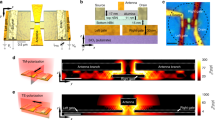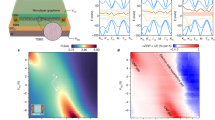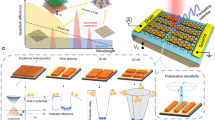Abstract
The requirements for broadband photodetection are becoming exceedingly demanding in hyperspectral imaging. While intrinsic photoconductor arrays based on mercury cadmium telluride represent the most sensitive and suitable technology, their optical spectrum imposes a narrow spectral range with a sharp absorption edge that cuts their operation to <25 μm. Here we demonstrate a large ultra-broadband photoconductivity in twisted double bilayer graphene heterostructures spanning the spectral range of 2–100 μm with internal quantum efficiencies of approximately 40% at speeds of 100 kHz. The large response originates from unique properties of twist-decoupled heterostructures including pristine, crystal field-induced terahertz band gaps, parallel photoactive channels and strong photoconductivity enhancements caused by interlayer screening of electronic interactions by respective layers acting as sub-atomic spaced proximity screening gates. Our work demonstrates a rare instance of an intrinsic infrared–terahertz photoconductor that is complementary metal-oxide-semiconductor compatible and array integratable, and introduces twist-decoupled graphene heterostructures as a viable route for engineering gapped graphene photodetectors with three-dimensional scalability.
This is a preview of subscription content, access via your institution
Access options
Access Nature and 54 other Nature Portfolio journals
Get Nature+, our best-value online-access subscription
$29.99 / 30 days
cancel any time
Subscribe to this journal
Receive 12 print issues and online access
$209.00 per year
only $17.42 per issue
Buy this article
- Purchase on Springer Link
- Instant access to full article PDF
Prices may be subject to local taxes which are calculated during checkout





Similar content being viewed by others
Data availability
The data that support the plots within this paper and other findings of this study are available from the corresponding authors upon reasonable request.
Code availability
All codes used to produce the findings of this study are available from the corresponding authors on reasonable request.
References
Richards, P. L. & McCreight, C. R. Infrared detectors for astrophysics. Phys. Today 58, 41–47 (2005).
Rieke, G. H. Infrared detector arrays for astronomy. Annu. Rev. Astron. Astrophys. 45, 77–115 (2007).
Mak, K. F. et al. Measurement of the optical conductivity of graphene. Phys. Rev. Lett. 101, 196405 (2008).
Gabor, N. M. et al. Hot carrier-assisted intrinsic photoresponse in graphene. Science. 334, 648–652 (2011).
Yan, J. et al. Dual-gated bilayer graphene hot-electron bolometer. Nat. Nanotechnol. 7, 472–478 (2012).
Deng, B. et al. Strong mid-infrared photoresponse in small-twist-angle bilayer graphene. Nat. Photonics 14, 549–553 (2020).
El Fatimy, A. et al. Epitaxial graphene quantum dots for high-performance terahertz bolometers. Nat. Nanotechnol. 11, 335–338 (2016).
Rogalski, A. HgCdTe infrared detector materials: history, status and outlook. Rep. Prog. Phys. 69, 2267 (2005).
Wang, F. et al. Gate-variable optical transitions in graphene. Science. 320, 206–209 (2008).
Zhang, Y. et al. Direct observation of a widely tunable bandgap in bilayer graphene. Nature 459, 820–823 (2009).
Rickhaus, P. et al. Gap opening in twisted double bilayer graphene by crystal fields. Nano Lett. 19, 8821–8828 (2019).
Wang, L. et al. One-dimensional electrical contact to a two-dimensional material. Science. 342, 614–617 (2013).
Cao, Y. et al. Superlattice-induced insulating states and valley-protected orbits in twisted bilayer graphene. Phys. Rev. Lett. 117, 116804 (2016).
Ju, L. et al. Tunable excitons in bilayer graphene. Science. 358, 907–910 (2017).
Rösch, M. et al. Heterogeneous terahertz quantum cascade lasers exceeding 1.9 THz spectral bandwidth and featuring dual comb operation. Nanophotonics. 7, 237–242 (2018).
Huang, P. et al. Ultra-long carrier lifetime in neutral graphene–hBN van der Waals heterostructures under mid-infrared illumination. Nat. Commun. 11, 1–9 (2020).
Schaller, R. D., Pietryga, J. M. & Klimov, V. I. Carrier multiplication in InAs nanocrystal quantum dots with an onset defined by the energy conservation limit. Nano Lett. 7, 3469–3476 (2007).
Josh, N. V. Photoconductivitiy Art, Science And Technology (CRC Press, 1990).
Icking, E. et al. Transport spectroscopy of ultraclean tunable band gaps in bilayer graphene. Adv. Electron. Mater. 8, 2200510 (2022).
Nam, Y., Ki, D. K., Soler-Delgado, D. & Morpurgo, A. F. Electron–hole collision limited transport in charge-neutral bilayer graphene. Nat. Phys. 13, 1207–1214 (2017).
Tan, C. et al. Dissipation-enabled hydrodynamic conductivity in a tunable bandgap semiconductor. Sci. Adv. 8, 1–8 (2022).
Kim, M. et al. Control of electron-electron interaction in graphene by proximity screening. Nat. Commun. 11, 2339 (2020).
Lu, C. P. et al. Local, global, and nonlinear screening in twisted double-layer graphene. Proc. Natl Acad. Sci. USA 113, 6623–6628 (2016).
Wu, X. et al. Boosting carrier mobility of synthetic few layer graphene on SiO2 by interlayer rotation and decoupling. Adv. Mater. Interfaces 5, 1–7 (2018).
Rickhaus, P. et al. The electronic thickness of graphene. Sci. Adv. 6, eaay8409 (2022).
Ulstrup, S. et al. Ultrafast dynamics of massive Dirac fermions in bilayer graphene. Phys. Rev. Lett. 112, 257401 (2014).
Huang, M. et al. Large-area single-crystal AB-bilayer and ABA-trilayer graphene grown on a Cu/Ni(111) foil. Nat. Nanotechnol. 15, 289–295 (2020).
Mannix, A. J. et al. Robotic four-dimensional pixel assembly of van der Waals solids. Nat. Nanotechnol. 17, 361–366 (2022).
Tomadin, A., Brida, D., Cerullo, G., Ferrari, A. C. & Polini, M. Nonequilibrium dynamics of photoexcited electrons in graphene: collinear scattering, Auger processes, and the impact of screening. Phys. Rev. B 88, 35430 (2013).
Rogalski, A. Semiconductor detectors and focal plane arrays for far-infrared imaging. Opto-Electronics Rev. 21, 406–426 (2013).
Kim, K. et al. Tunable moiré bands and strong correlations in small-twist-angle bilayer graphene. Proc. Natl Acad. Sci. USA 114, 3364–3369 (2017).
Pizzocchero, F. et al. The hot pick-up technique for batch assembly of van der Waals heterostructures. Nat. Commun. 7, 11894 (2016).
Purdie, D. G. et al. Cleaning interfaces in layered materials heterostructures. Nat. Commun. 9, 1–12 (2018).
Ferrari, A. C. et al. Raman spectrum of graphene and graphene layers. Phys. Rev. Lett. 97, 187401 (2006).
Acknowledgements
We thank D. B. Ruiz, S. Castilla, D. De Fazio, M. Amir Ali, G. Li, A. Berdyugin, M. Polini, V. Mkhitaryan, G. Kumar, and I. Torre for technical discussions. We further thank M. Ceccanti for making the illustration presented in Fig. 1a. H.A., K.N. and R.B. acknowledge funding from the European Union’s Horizon 2020 research and innovation programme under Marie Skłodowska-Curie grant agreement no. 665884, 713729 and 847517, respectively. S.B.-P. acknowledges funding from the Presidencia de la Agencia Estatal de Investigación within the PRE2020-094404 predoctoral fellowship. G.S. and A.F. gratefully acknowledge funding from the ERC grant CHIC (no. 724344), and J. Faist for discussions. A.P. acknowledges support from the European Union’s Horizon 2020 research and innovation programme under Marie Sklodowska-Curie grant agreement no. 873028 and from the Leverhulme Trust under grant agreement RPG-2019-363. K.W. and T.T. acknowledge support from the Elemental Strategy Initiative conducted by MEXT Japan with grant no. JPMXP0112101001, JSPS KAKENHI (JP19H05790, JP20H00354 and JP21H05233) and CREST (JPMJCR15F3), JST. R.K.K. acknowledges the EU Horizon 2020 programme under MarieSkłodowska-Curie grants 754510 and 893030 and the FLAG-ERA grant (PhotoTBG, PCI2021-122020-2A), by ICFO, RWTH Aachen and ETHZ/Department of Physics. A.B. acknowledges support from ERC advanced grant no. 692876, MICINN grant no. RTI2018-097953-B-I00 and PID2021-122813OB-I00, AGAUR (grant no. 2017SGR1664), the Fondo Europeo de Desarrollo, the Spanish Ministry of Economy and Competitiveness through Quantum CCAA, EUR2022-134050, and CEX2019-000910-S [MCIN/AEI/10.13039/501100011033], MCIN with funding from European Union NextGenerationEU (PRTR-C17.I1), Fundacio Cellex, Fundacio Mir-Puig, Generalitat de Catalunya through CERCA. F.H.L.K. acknowledges support from the ERC TOPONANOP (726001), Fundació Cellex, Fundació Mir-Puig, Generalitat de Catalunya (CERCA, AGAUR, SGR 1656, program TWIST), the Government of Spain [PID2019-106875GB-I00; PCI2021-122020-2A; PDC2022-133844-I00 (Teracomm); Severo Ochoa CEX2019-000910-S] funded by MCIN/AEI/10.13039/501100011033 and by the European Union NextGenerationEU/PRTR. Furthermore, the research leading to these results has received funding from the European Union’s Horizon 2020 research and innovation programme under grant agreement no. 881603 (Graphene flagship Core3), 820378 (Quantum flagship) and 101034929 (Fastera). This material is based upon work supported by the Air Force Office of Scientific Research under award number FA8655-23-1-7047. Any opinions, findings, and conclusions or recommendations expressed in this material are those of the author(s) and do not necessarily reflect the views of the United States Air Force.
Author information
Authors and Affiliations
Contributions
F.H.L.K., H.A. and R.K.K. conceived the presented idea. H.A. fabricated the devices. H.A. and K.N. performed the mid-infrared measurements with inputs from R.K.K. and F.H.L.K. K.N. built the mid-infrared measurement setup with inputs from A.R.-P., R.K.K. and F.H.L.K. R.K.K, and H.A. performed terahertz far-field photocurrent measurements A.R.-P, R.K.K. and H.A. designed and built the measurement setup for terahertz photocurrent experiments. A.F., H.A. and G.S. performed low-temperature FTIR spectroscopy measurements. A.P., R.K.K. and F.H.L.K. developed the theoretical formalism and performed the analytical calculations. R.B. performed absorption calculations. K.W. and T.T. provided hBN crystals. H.A, P.P., L.V. and A.B. performed magnetotransport experiments. H.A., K.N. and R.K.K. analysed the results. R.K.K., H.A. and F.H.L.K. wrote the manuscript. R.K.K. and F.H.L.K. supervised the project. All authors provided critical feedback and helped shape the research, analysis and manuscript.
Corresponding authors
Ethics declarations
Competing interests
The authors declare no competing interests.
Peer review
Peer review information
Nature Photonics thanks the anonymous reviewers for their contribution to the peer review of this work.
Additional information
Publisher’s note Springer Nature remains neutral with regard to jurisdictional claims in published maps and institutional affiliations.
Supplementary information
Supplementary Information
Supplementary Sections 1–9.
Rights and permissions
Springer Nature or its licensor (e.g. a society or other partner) holds exclusive rights to this article under a publishing agreement with the author(s) or other rightsholder(s); author self-archiving of the accepted manuscript version of this article is solely governed by the terms of such publishing agreement and applicable law.
About this article
Cite this article
Agarwal, H., Nowakowski, K., Forrer, A. et al. Ultra-broadband photoconductivity in twisted graphene heterostructures with large responsivity. Nat. Photon. 17, 1047–1053 (2023). https://doi.org/10.1038/s41566-023-01291-0
Received:
Accepted:
Published:
Issue Date:
DOI: https://doi.org/10.1038/s41566-023-01291-0
This article is cited by
-
Large-angle twist effect
Nature Photonics (2023)



